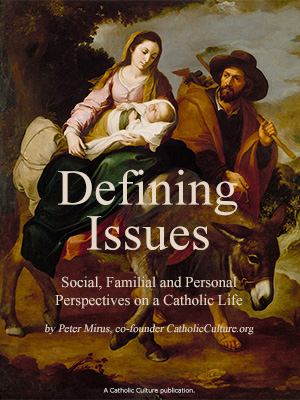Catholic Activity: St. John Paul II on Modesty
Quote from Love and Responsibility, by then Karol Wojtyla, pp. 189-192.
DIRECTIONS
We have already touched on the question of dress. It is one of the matters concerning which problems of modesty and shamelessness most frequently arise. It is difficult for us to go into details or to discuss the nuances of fashion in male and female dress. These matters certainly have a bearing on the problem of modesty and shamelessness, though the connection is perhaps not that which is commonly thought to exist. Dress can, of course, help to accentuate the sexual values in different ways - in different ways on different occasions, irrespective of the congenital or acquired dispositions of a particular individual. This accentuation of sexual values by dress is inevitable, and is not necessarily incompatible with sexual modesty. What is truly immodest in dress is that which frankly contributes to the deliberate displacement of the true value of the person by sexual values, that which is bound to elicit a reaction to the person as to a 'possible means of obtaining sexual enjoyment' and not 'a possible object of love by reason of his or her personal value'.
The principle is simple and obvious, but its application in specific cases depends upon the individual, the milieu, the society. Dress is always a social question, a function of (healthy or unhealthy) social customs. We must simply stress that although considerations of an aesthetic nature may seem to be decisive here they are not and cannot be the only ones: considerations of an ethical nature exist side by side with them. Man, alas, is not such a perfect being that the sight of the body of another person, especially a person of the other sex, can arouse in him merely a disinterested liking which develops into an innocent affection. In practice it also arouses concupiscence, or a wish to enjoy concentrated on sexual values with no regard for the value of the person. And this must be taken into account.
This does not, however, mean that physical shamelessness is to be simply and exclusively identified with complete or partial nakedness. There are circumstances in which nakedness is not immodest. If someone takes advantage of such an occasion to treat the person as an object of enjoyment, (even if his action is purely internal) it is only he who is guilty of shamelessness (immodesty of feeling), not the other. Nakedness as such is not to be equated with physical shamelessness. Immodesty is present only when nakedness plays a negative role with regard to the value of the person, when its aim is to arouse concupiscence, as a result of which the person is put in the position of an object for enjoyment. What happens then may be called depersonalization by sexualization. But this is not inevitable. Even when nakedness goes with mutual sexual enjoyment respect for the dignity of the person can be fully preserved. This is how it must be in marriage, where there exist the objective conditions for the genuine absorption of shame by love....
Although physical immodesty cannot be identified in a simple way with nakedness as such, it none the less requires a real internal effort to refrain from reacting to the naked body in an immodest way. It should however be added that there is a difference between immodesty in feelings on the one hand and reflex sensual reactions to the body and sex as a 'possible object of enjoyment' on the other. The human body is not in itself shameful, nor for the same reasons are sensual reactions, and human sensuality in general. Shamelessness (just like shame and modesty) is a function of the interior of a person, and specifically of the will, which too easily accepts the sensual reaction and reduces another person, because of the person's 'body and sex', to the role of an object for enjoyment.
While we are on the subject of dress and its relevance to the problem of modesty and immodesty it is worth drawing attention to the functional significance of differences in attire. There are certain objective situations in which even total nudity of the body is not immodest, since the proper function of nakedness in this context is not to provoke a reaction to the person as an object for enjoyment, and in just the same way the functions of particular forms of attire may vary. Thus, the body may be partially bared for physical labour, for bathing, or for a medical examination. If then we wish to pass a moral judgment on particular forms of dress we have to start from the particular functions which they serve. When a person uses such a form of dress in accordance with its objective function we cannot claim to see anything immodest in it, even if it involves partial nudity. Whereas the use of such a costume outside its proper context is immodest, and is inevitably felt to be so.
For example, there is nothing immodest about the use of a bathing costume at a bathing place, but to wear it in the street or while out for a walk is contrary to the dictates of modesty. It would be wrong not to refer here, if only cursorily, to another particular problem, that of pornography (or shamelessness) in art. It is a very broad problem, and extremely complex on detailed examination, because of the diversity of the arts. I am concerned for the present only to define the gist of the problem. An artist communicates in his work his own thoughts, feelings, and attitudes, but his work does not only serve this purpose. It serves the truth, in that it must capture and transmit some fragment of reality in a beautiful way.






